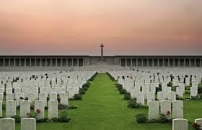| First Name: | Frederick Harold | Last Name: | PIERCY | |
|---|---|---|---|---|
| Date of Death: | 28/03/1918 | Lived/Born In: | Bloomsbury | |
| Rank: | Private | Unit: | Royal West Kent7 | |
| Memorial Site: | Pozieres Memorial, France | |||
Current Information:Age-20 16, Southampton Street, Bloomsbury Square
With an end to the fighting on the Eastern Front after the Russian Revolution, Germany was able to bring its troops from there to France and launch a series of offensives in the Spring of 1918, designed to bring the war to a swift conclusion. Four times between March and July they attacked in strength and on each occasion they broke through the British and French lines and made spectacular gains but in each case they over extended themselves and without adequate supplies keeping up with their rapid advances, they could go no further. The first of these attacks, Operation Michael, was made on 21st March by 63 specially trained divisions, attacking along a 60 mile front held by 26 British divisions, many of them in a weakened state At 4.40am the German artillery opened up with the most ferocious and concentrated bombardment of the war, the likes of which the British had never experienced before. The Forward Zone, consisting mainly of individual posts was blown away. Very few of the men there made it back. Many were killed and many more were taken prisoner. The Battle Zone was also battered as were the British guns, firing from positions just to the rear. Brigade and Divisional HQs were targeted as well and then, from out of the thick mist came the German storm troopers. Moving fast, they skirted round the few remaining strongholds and penetrated deep into the British lines, including those of the Battle Zone, causing the utmost confusion. There were many cases of heroic stands being made but the relentless pressure forced the British back everywhere and there then began a general retreat that went on for two weeks and which ceded to the Germans a huge amount of territory, including all of that that had been won at such great cost during the Battle of the Somme in 1916. When the German attack was unleashed on 21st March, the 7th Royal West Kent battalion of 53 Brigade, 18th Division, were in the front line to the south of St Quentin. A and C Companies were in the front posts and so severe was the bombardment of their positions that very few made it back from there. All overhead shelters at Battalion HQ at Durham Post on the Moy-Ly Fontaine road, were destroyed and with all wires cut and very few runners getting through, communications were completely broken. At 11am, the infantry attack arrived at Drummond Road, just east of the Vendhuile-St Quentin road, where D Company were in support. The enemy got close to the post there and under cover of the mist they poured in machine-gun fire from both flanks. The defenders were overwhelmed and very few escaped. The attack on Battalion HQ itself was at first held off but by 11am B Company, the reserve company, were surrounded and resistance ended soon after 2pm. Very few of 7th Royal West Kent, about twenty in total, made it back to Brigade HQ that evening. A composite battalion of the survivors of 53 Brigade was formed and over the next week it joined the general retreat of Fifth Army back almost to Amiens, fighting rear guard actions all the way. By 28th March the battalion had reached Gentelles, just south of Amiens, and in the evening moved forward to positions between Hangard and Villers-Bretonneux. Although the casualty list for 28th March, which includes Frederick Piercy, is a very long one, the Battalion Diary makes no mention of any fighting, nor of any casualties on this day so it is almost definitely the case that most of these men were killed on 21st March. However in the confusion of the battle and the subsequent retreat, it was not until a week later that there was time to make a full assessment of all the casualties and record their deaths. |
||||
| « Back to Search Results | ||||
| If you think any of the information shown here is incorrect, Click Here to submit your amends and comments | ||||




